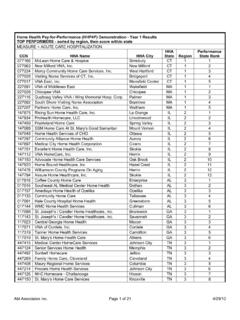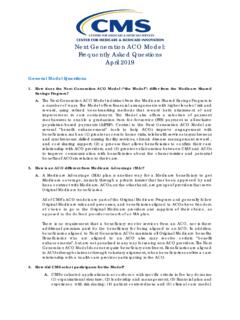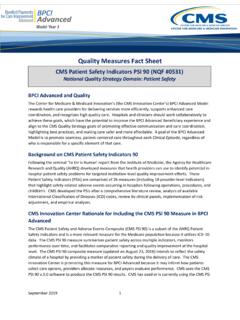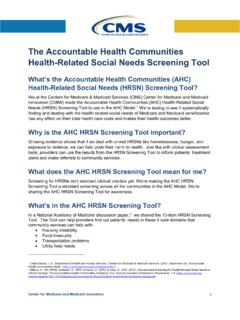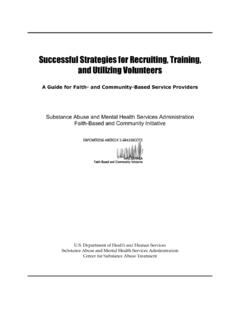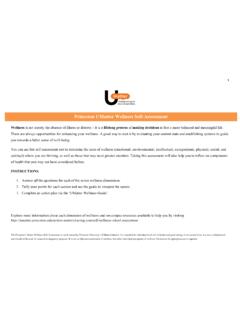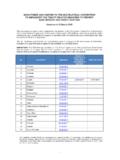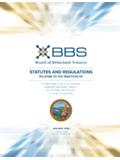Transcription of Care Coordination Toolkit
1 1 care CoordinationToolkitCare Coordination ToolkitMarch 2019 Overview of the CMS ACO Learning System and ToolkitSince 2012, CMS has supported ACOs in their efforts to improve the delivery of care for their attributed patient populations through model-specific learning systems. These learning systems provide ACOs with a forum in which they can collaborate with and learn from one another. Across the model-specific learning systems, CMS hosts approximately 70 virtual events and 18 in-person events each year on topics tailored to meet the needs and interests of current ACOs. This care Coordination Toolkit describes a variety of strategies used by ACOs to ensure that attributed beneficiaries receive both high-quality and efficient care . By managing transitions across the settings of care , ACOs are able to tailor care to the beneficiaries unique needs.
2 This is the first Toolkit in a broader series of resources that will explore different aspects of how ACOs operate to provide value-based care . The toolkits will bring together insights gathered during CMS-sponsored learning system events and through focus groups with the ACOs. Through these toolkits, CMS aims to educate the general public about strategies used by ACOs to provide value-based care while also providing actionable ideas to current and prospective ACOs to help them improve or begin operations. IntroductionNumerous Medicare accountable care organizations (ACOs) have achieved shared savings since 2012 by using various strategies to improve population health and quality while reducing costs. Recognizing that each ACO has a different approach to successfully providing value-based care , the Centers for Medicare & Medicaid Services (CMS) is developing a series of toolkits that explore different aspects of ACO operations.
3 Through these toolkits, CMS aims to educate the general public about strategies used by ACOs to provide value-based care while also providing actionable ideas to current and prospective ACOs to help them improve or begin operations, particularly as they consider a shift to a two-sided risk Toolkit highlights an array of innovative care Coordination strategies that Medicare ACOs use to collaborate with beneficiaries, clinicians, and post-acute care partners to ensure high-quality effective care is provided at the right time and in the right setting. ACOs use a variety of methods to coordinate and manage the care of their diverse beneficiary populations. Approaches to care Coordination includes both system-wide initiatives and targeted interventions that support individuals with chronic conditions or recent acute care needs.
4 Some ACOs focus on facilitating the exchange of data between primary care providers (PCPs) and emergency departments (EDs), whereas others establish networks of post-acute care partners to support their mission of improving the quality and effectiveness of care . Others developed initiatives that focus on managing the care of individual beneficiaries, such as launching a home visit program or using information technology to streamline referrals to community organizations. 2 care Coordination ToolkitMarch 2019 Regardless of how ACOs approach care Coordination , the individual beneficiary should always remain at the center of their processes and programs. This Toolkit explores the development and implementation of different ACO care Coordination strategies. Specifically, this Toolkit explains how ACOs support and coordinate care for beneficiaries who: Receive emergent care in the ED Require treatment in a skilled nursing facility (SNF) Have recently been discharged home after a hospital or ED visit Have been diagnosed with a chronic condition Have conditions affected by the social determinants of health In exploring how ACOs coordinate care for beneficiaries in these five areas, this Toolkit describes ACO strategies to enhance collaboration with post-acute care providers, facilitate the sharing of beneficiary information between clinicians, and leverage community resources for beneficiaries with complex care needs.
5 To produce this Toolkit , the CMS ACO learning system conducted focus groups and individual interviews with representatives from 21 ACOs that participate in the Shared Savings Program, the Next Generation ACO Model, and the Comprehensive End-Stage Renal Disease (ESRD) care (CEC) The learning system invited ACOs that had previously shared effective care Coordination strategies during past learning system During each focus group, the participants described strategies for managing care across different settings and for coordinating care for high-risk, high-need beneficiaries. For a list of the ACOs that contributed strategies to this Toolkit , please see page many of the ACOs who contributed to this Toolkit focused on strategies that yielded positive results, some ACOs candidly discussed programs that were less successful than expected or initiatives that, as of this writing, are in the early stages, so results are not yet available.
6 Lessons learned from attempted interventions are included in the Toolkit , along with examples of snapshots that offer current and prospective ACOs a holistic sense of available options and possible implementation challenges. disclaimer : This document is a compilation of strategies and tactics designed to help ACOs coordinate care for their attributed beneficiaries. Although every reasonable effort has been made to assure the accuracy of the information within these pages, the ultimate responsibility for creating change lies with the provider of services. CMS employees, agents, and staff make no representation, warranty, or guarantee that this compilation of strategies is error-free and will bear no responsibility or liability for the results or consequences of the use of this Throughout this Toolkit , we use the term ACO inclusively when discussing strategies mentioned by both ACOs and ESRD Seamless care Organizations (ESCOs).
7 However, if a strategy was mentioned only by an ESCO, then we indicated it as such. For context, ESCOs are a type of ACO operated by dialysis organizations that focus specifically on beneficiaries diagnosed with ESRD. For more information about CMS s ACO models, see this website: 2 When considering which ACOs to include in the focus groups, we did not limit invitations strictly to ACOs or ESCOs that had consistently achieved shared savings. Doing so could have inadvertently excluded ACOs that were starting out in new, higher risk programs or were making infrastructure investments that created situations in which they accepted short-term losses to position themselves and their beneficiaries for longer-term financial and quality Coordination ToolkitMarch 20193 care Coordination for Beneficiaries Who Receive Emergent care in the EDACOs emphasized the importance of coordinating care for beneficiaries after an ED visit.
8 Ideally, when an ACO-attributed beneficiary uses ED services, the ED care team relays information from the visit to the ACO and key care team members so that they can determine the appropriateness of care management services and any necessary refinements to patients care plans. Too often, however, this information is not communicated to the ACO or to key care team members, such as the PCP or care manager. To address this gap in care Coordination and ensure the beneficiary s experience and care needs remain the focal point, ACOs have adopted strategies to engage hospital leadership, embed staff within the ED, and encourage communication with ED clinicians. ENGAGING HOSPITAL LEADERSHIP IN ED care Coordination INITIATIVES Before developing and implementing ED-related care Coordination initiatives with frontline staff, some ACOs sought to establish collaborative relationships with hospital leadership and administrators.
9 One ACO noted the value of regular in-person interactions between hospitalists, ED physicians, and community PCPs at recurring meetings of the ACO s board of managers. The presence of hospital leadership at these meetings allowed for open discussions about shared care delivery reform goals and facilitated a more collaborative approach to the co-management of patients. Through the multiple perspectives offered in the meetings, the ACO sought to achieve the following objec-tives: (1) establish common ground between ED clinicians and PCPs about care improvement strategies; (2) gather insight and information from the frontline clinicians in the ED, hospital, and community-based primary care practices; and (3) foster evolving relationships between urgent care providers and PCPs to encourage increased communication through beneficiaries care ED visit.
10 EMBEDDING STAFF WITHIN THE ED TO PROMOTE care COORDINATIONM ultiple ACOs focused on approaches to embed care managers within the ED in order to provide beneficiaries with timely care Coordination . ACOs rely on these embedded care managers to spearhead communication and collaboration between ED clinicians and PCPs. Embedded care managers are able to access information on patients previous health needs from the EHR to share with ED clinicians and can assist with discharge and transfer from the ED to another care setting or to the home. ACOs noted that embedded care managers are particularly impactful in cases where beneficiaries with ambulatory sensitive conditions require additional support to safely transition back to their home. Embedded care managers also help to close information gaps if an ACO s clinicians and hospitals use EHRs that lack interoperability.
